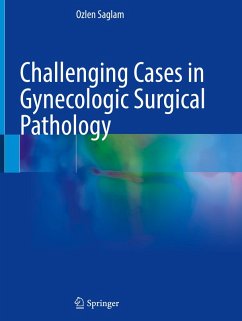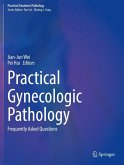Ozlen Saglam
Challenging Cases in Gynecologic Surgical Pathology
Ozlen Saglam
Challenging Cases in Gynecologic Surgical Pathology
- Gebundenes Buch
- Merkliste
- Auf die Merkliste
- Bewerten Bewerten
- Teilen
- Produkt teilen
- Produkterinnerung
- Produkterinnerung
Challenging Cases in Gynecologic Surgical Pathology discusses unusual clinical cases and uncommon presentations of usual diagnostic entities. The book is divided into four sections that contain over 14 years of teaching material from major academic institutions and cancer centers. The pathology case presentations are from different anatomical sites of the gynecological tract, including ovary and fallopian tubes, uterine corpus, cervix, and vulva. The chapters within each section contain epithelial, mesenchymal, or germ cell tumors and mimickers of cancer. Each case title has a brief clinical…mehr
Andere Kunden interessierten sich auch für
![Practical Gynecologic Pathology Practical Gynecologic Pathology]() Practical Gynecologic Pathology130,99 €
Practical Gynecologic Pathology130,99 €![Practical Gynecologic Pathology Practical Gynecologic Pathology]() Practical Gynecologic Pathology123,04 €
Practical Gynecologic Pathology123,04 €![Challenging Cases in Diagnostic Clinical Microbiology Challenging Cases in Diagnostic Clinical Microbiology]() Challenging Cases in Diagnostic Clinical Microbiology146,99 €
Challenging Cases in Diagnostic Clinical Microbiology146,99 €![Challenging Cases in Dermatology Volume 2 Challenging Cases in Dermatology Volume 2]() Mohammad Ali El-DaroutiChallenging Cases in Dermatology Volume 2111,99 €
Mohammad Ali El-DaroutiChallenging Cases in Dermatology Volume 2111,99 €![Challenging Cases in Dermatology Volume 2 Challenging Cases in Dermatology Volume 2]() Mohammad Ali El-DaroutiChallenging Cases in Dermatology Volume 281,99 €
Mohammad Ali El-DaroutiChallenging Cases in Dermatology Volume 281,99 €![Diagnostic Procedures in Patients with Neck Masses Diagnostic Procedures in Patients with Neck Masses]() Diagnostic Procedures in Patients with Neck Masses41,99 €
Diagnostic Procedures in Patients with Neck Masses41,99 €![Atlas of Gynecologic Surgical Pathology Atlas of Gynecologic Surgical Pathology]() Philip B. ClementAtlas of Gynecologic Surgical Pathology366,99 €
Philip B. ClementAtlas of Gynecologic Surgical Pathology366,99 €-
-
-
Challenging Cases in Gynecologic Surgical Pathology discusses unusual clinical cases and uncommon presentations of usual diagnostic entities. The book is divided into four sections that contain over 14 years of teaching material from major academic institutions and cancer centers. The pathology case presentations are from different anatomical sites of the gynecological tract, including ovary and fallopian tubes, uterine corpus, cervix, and vulva. The chapters within each section contain epithelial, mesenchymal, or germ cell tumors and mimickers of cancer. Each case title has a brief clinical correlation at the end.
The sample cases therein may be diagnostically challenging for practicing pathologists in routine practice or relatively recently described entities. The intent of the book is not a complete review of gynecologic pathology. Instead, the focus is on unusual patterns of common gynecologic pathology cases and uncommon tumors of the gynecological tractwith their relevant clinical work-up and differential diagnosis. The case illustrations provide a practical approach to diagnosing challenging gynecologic cancers. The aim is to be a valuable resource for practicing general pathologists and pathology trainees who encounter complicated cases in daily practice.
Hinweis: Dieser Artikel kann nur an eine deutsche Lieferadresse ausgeliefert werden.
The sample cases therein may be diagnostically challenging for practicing pathologists in routine practice or relatively recently described entities. The intent of the book is not a complete review of gynecologic pathology. Instead, the focus is on unusual patterns of common gynecologic pathology cases and uncommon tumors of the gynecological tractwith their relevant clinical work-up and differential diagnosis. The case illustrations provide a practical approach to diagnosing challenging gynecologic cancers. The aim is to be a valuable resource for practicing general pathologists and pathology trainees who encounter complicated cases in daily practice.
Hinweis: Dieser Artikel kann nur an eine deutsche Lieferadresse ausgeliefert werden.
Produktdetails
- Produktdetails
- Verlag: Springer / Springer Nature Switzerland / Springer, Berlin
- Artikelnr. des Verlages: 978-3-031-51655-9
- 2023
- Seitenzahl: 156
- Erscheinungstermin: 27. Februar 2024
- Englisch
- Abmessung: 285mm x 215mm x 12mm
- Gewicht: 697g
- ISBN-13: 9783031516559
- ISBN-10: 3031516559
- Artikelnr.: 69538051
- Herstellerkennzeichnung Die Herstellerinformationen sind derzeit nicht verfügbar.
- Verlag: Springer / Springer Nature Switzerland / Springer, Berlin
- Artikelnr. des Verlages: 978-3-031-51655-9
- 2023
- Seitenzahl: 156
- Erscheinungstermin: 27. Februar 2024
- Englisch
- Abmessung: 285mm x 215mm x 12mm
- Gewicht: 697g
- ISBN-13: 9783031516559
- ISBN-10: 3031516559
- Artikelnr.: 69538051
- Herstellerkennzeichnung Die Herstellerinformationen sind derzeit nicht verfügbar.
Ozlen Saglam, MD Oregon Health and Science University Department of Pathology and Laboratory Medicine Portland, OR USA
Section 1: The Ovarian and Fallopian Tube Pathology Cases.- Chapter 1: Epithelial Ovarian Lesions.- Case Title 1: Endometrioid Carcinoma with Spindle Cells (ECSC).- Case Title 2: Endometrioid Adenocarcinoma with Sertoliform Pattern.- Case Title 3: Low-grade Serous Carcinoma (LGSC) in the background of Serous Borderline Tumor (SBT).- Case Title 4: Lymph Node Involvement by Serous Borderline Tumor.- Case Title 5: High-grade Serous Carcinoma with Solid Endometrioid-like and Transitional (SET) Pattern.- Case Title 6: High-grade Serous Carcinoma with Treatment Effect.- Case Title 7: High-grade Serous Carcinoma with microcytic pattern (mucinous differentiation).- Case Title 8: Mucinous Borderline Tumor with Intraepithelial (non-invasive) Carcinoma (MBT with IECA).- Case Title 9: Serous Borderline Tumor (SBT) with Extraovarian Disease (Implants).- Case Title 10: Borderline Brenner Tumor with Mucinous Metaplasia.- Chapter2: Fallopian Tube Lesions.- Case Title 11: Papillary Tubal Hyperplasia (PTH).- Case Title 12: High-grade Serous Carcinoma in the Background of Serous Tubal Intraepithelial Carcinoma (STIC).- Case Title 13: Mucinous Metaplasia of Bilateral Fallopian Tubes in Peutz-Jeghers Syndrome (PJS).- Chapter 3: Sex Cord Stromal Tumors of the Ovaries and its Mimickers.- Case Title 14: Cellular Fibroma (CF).- Case Title 15: Cystic Adult Granulosa Cell Tumor (AGCT).- Case Title 16: Sertoli Leydig Cell Tumor (SLCT) with Heterologous Elements.- Case Title 17: Juvenile Granulosa Cell Tumor (JGCT).- Case Title 18: Adult Granulosa Cell Tumor (AGCT) with prominent fibromatous component (diffuse pattern).- Case Title 19: Luteinized Adult Granulosa Cell Tumor.- Case Title 20: Stromal Hyperplasia and Hyperthecosis.- Case Title 21: Leydig Cell Tumor (LCT).- Case Title 22: Steroid Cell Tumor (SCT).- Case Title 23: Microcytic Stromal Tumor (MST).- Case Title 24: Gynandroblastoma.- Case Title 25: Sertoli Leydig Cell Tumor with retiform pattern.- Chapter 4: Germ Cell Tumors.- Case Title 26: Well-differentiated Neuroendocrine Tumor (WNET) in the background Mature Teratoma.- Case Title 27: Immature teratoma with embryoid bodies (Malignant Mixed Germ Cell Tumor).- Case Title 28: Struma Ovarii.- Chapter 5: Miscellaneous Ovarian Lesions.- Case Title 29: Small Cell Carcinoma of the ovary, hypercalcemic type (SCCOHT).- Case Title 30: Anastomosing Hemangioma.- Section 2: Uterine Corpus Pathology Cases.- Chapter 6: Endometrium.- Case Title 1: Corded and Hyalinized Endometrioid Carcinoma (CHEC).- Case Title 2: Metastatic Carcinoma Involving the Endometrium.- Case Title 3: Endometrioid Carcinoma with Mucinous Features.- Case Title 4: Low-grade Endometrioid Adenocarcinoma with Clear Cells.- Case Title 5: Low-grade Endometrioid Adenocarcinoma with Papillary Architecture.- Case Title 6: Endometrioid Carcinoma with Microcystic Elongated and Fragmented (MELF) Pattern of Myometrial Invasion.- Case Title 7: Endometrioid Adenocarcinoma with Progestin Treatment Effect.- Case Title 8: Endometrial Mucinous Metaplasia with Complex Architecture.- Case Title 9: Polypoid Adenomyoma (PAM).- Case Title 10: Atypical Polypoid Adenomyoma (APA).- Case Title 11: Mesonephric-like Adenocarcinoma.- Case Title 12: Undifferentiated/dedifferentiated carcinoma.- Case Title 13: Clear Cell Carcinoma, oxyphilic type.- Case Title 14: Mixed Neuroendocrine and Endometrioid Carcinoma.- Case Title 15: Yolk Sac Tumor of the Endometrium.- Chapter 7: Mesenchymal Lesions.- Case Title 16: Leiomyoma with hydropic change.- Case Title 17: Epithelioid Leiomyoma.- Case Title 18: Intravenous Leiomyomatosis (IVL).- Case Title 19: Disseminated Peritoneal Leiomyomatosis (DPL).- Case Title 20: Cotyledonoid Dissecting Leiomyoma (CDLM).- Case Title 21: Fumarate Hydratase Deficient Leiomyoma (FH-leiomyoma).- Case Title 22: Leiomyomas with bizarre nuclei (Symplastic leiomyoma).- Case Title 23: Epithelioid Leiomyosarcoma (ELMS).- Case Title 24: Cellular Leiomyoma.- Case Title 25: Perivascular Epithelioid Cell Neoplasm (PEComa).- Case Title 26: Solitary Fibrous Tumor (SFT).- Case Title 27: Myxoid Leiomyosarcoma (LMS).- Case Title 28: Mullerian Adenosarcoma (MA) with Stromal Overgrowth.- Chapter 8: Miscellaneous Uterine Lesions.- Case Title 29: Uterine Tumor Resembling Ovarian Sex Cord Tumor (UTROSCT).- Section 3: Uterine Cervix Pathology Cases.- Chapter 9: Uncommon Tumors and mimickers of cancer.- Case Title 1: Mesonephric Hyperplasia (MH).- Case Title 2: Endocervicosis.- Case Title 3: HPV-associated invasive endocervical adenocarcinoma (EAC) with SilvaPattern A.- Case Title 4: Gastric-type Adenocarcinoma (HPV-independent adenocarcinoma) (GAS).- Case Title 5: Neurotrophic tyrosine receptor kinase (NTRK)-rearranged spindle cell neoplasm.- Case Title 6: Epithelioid Trophoblastic Tumor (ETT).- Case Title 7: Residual endocervical adenocarcinoma with treatment effect.- Case Title 8: Small Cell Neuroendocrine Carcinoma of the Cervix (SCNEC).- Case Title 9: Stratified Mucin-Producing Intraepithelial Lesion (SMILE).- Case Title 10: Embryonal Rhabdomyosarcoma (ERMS), botryoid type.- Section 4: Vulvar Pathology Cases.- Chapter 10: Uncommon Tumors and mimickers of cancer.- Case Title 1: Nodular Hyperplasia (NH) of Bartholin Glands (BG).- Case Title 2: Hidradenoma Papilliferum (Papillary hidradenoma) (HP).- Case Title 3: Molluscum Contagiosum.- Case Title 4: Fibroepithelial polyp (FEP) with giant stromal cells.- Case Title 5: Hibernoma.- Case Title 6: Cellular Angiofibroma (CA).- Case Title 7: Schwannoma with Intralesional Nodularity.- Case Title 8: Extramammary Paget's disease with underlying adenocarcinoma.- Case Title 9: Basal Cell Carcinoma (BCC) of the Vulva, Nodular/Adenoid subtype.- Case Title 10: Differentiated Vulvar Intraepithelial Neoplasia (dVIN) (HPV- independent VIN).- Case Title 11: Deep (Aggressive) Angiomyxoma (AA).- Case Title 12: Pseudovascular Squamous Cell Carcinoma.- Pseudoangiosarcomatous Carcinoma). - Case Title 13: Epithelioid hemangioendothelioma (EHE).
Section 1: The Ovarian and Fallopian Tube Pathology Cases.- Chapter 1: Epithelial Ovarian Lesions.- Case Title 1: Endometrioid Carcinoma with Spindle Cells (ECSC).- Case Title 2: Endometrioid Adenocarcinoma with Sertoliform Pattern.- Case Title 3: Low-grade Serous Carcinoma (LGSC) in the background of Serous Borderline Tumor (SBT).- Case Title 4: Lymph Node Involvement by Serous Borderline Tumor.- Case Title 5: High-grade Serous Carcinoma with Solid Endometrioid-like and Transitional (SET) Pattern.- Case Title 6: High-grade Serous Carcinoma with Treatment Effect.- Case Title 7: High-grade Serous Carcinoma with microcytic pattern (mucinous differentiation).- Case Title 8: Mucinous Borderline Tumor with Intraepithelial (non-invasive) Carcinoma (MBT with IECA).- Case Title 9: Serous Borderline Tumor (SBT) with Extraovarian Disease (Implants).- Case Title 10: Borderline Brenner Tumor with Mucinous Metaplasia.- Chapter2: Fallopian Tube Lesions.- Case Title 11: Papillary Tubal Hyperplasia (PTH).- Case Title 12: High-grade Serous Carcinoma in the Background of Serous Tubal Intraepithelial Carcinoma (STIC).- Case Title 13: Mucinous Metaplasia of Bilateral Fallopian Tubes in Peutz-Jeghers Syndrome (PJS).- Chapter 3: Sex Cord Stromal Tumors of the Ovaries and its Mimickers.- Case Title 14: Cellular Fibroma (CF).- Case Title 15: Cystic Adult Granulosa Cell Tumor (AGCT).- Case Title 16: Sertoli Leydig Cell Tumor (SLCT) with Heterologous Elements.- Case Title 17: Juvenile Granulosa Cell Tumor (JGCT).- Case Title 18: Adult Granulosa Cell Tumor (AGCT) with prominent fibromatous component (diffuse pattern).- Case Title 19: Luteinized Adult Granulosa Cell Tumor.- Case Title 20: Stromal Hyperplasia and Hyperthecosis.- Case Title 21: Leydig Cell Tumor (LCT).- Case Title 22: Steroid Cell Tumor (SCT).- Case Title 23: Microcytic Stromal Tumor (MST).- Case Title 24: Gynandroblastoma.- Case Title 25: Sertoli Leydig Cell Tumor with retiform pattern.- Chapter 4: Germ Cell Tumors.- Case Title 26: Well-differentiated Neuroendocrine Tumor (WNET) in the background Mature Teratoma.- Case Title 27: Immature teratoma with embryoid bodies (Malignant Mixed Germ Cell Tumor).- Case Title 28: Struma Ovarii.- Chapter 5: Miscellaneous Ovarian Lesions.- Case Title 29: Small Cell Carcinoma of the ovary, hypercalcemic type (SCCOHT).- Case Title 30: Anastomosing Hemangioma.- Section 2: Uterine Corpus Pathology Cases.- Chapter 6: Endometrium.- Case Title 1: Corded and Hyalinized Endometrioid Carcinoma (CHEC).- Case Title 2: Metastatic Carcinoma Involving the Endometrium.- Case Title 3: Endometrioid Carcinoma with Mucinous Features.- Case Title 4: Low-grade Endometrioid Adenocarcinoma with Clear Cells.- Case Title 5: Low-grade Endometrioid Adenocarcinoma with Papillary Architecture.- Case Title 6: Endometrioid Carcinoma with Microcystic Elongated and Fragmented (MELF) Pattern of Myometrial Invasion.- Case Title 7: Endometrioid Adenocarcinoma with Progestin Treatment Effect.- Case Title 8: Endometrial Mucinous Metaplasia with Complex Architecture.- Case Title 9: Polypoid Adenomyoma (PAM).- Case Title 10: Atypical Polypoid Adenomyoma (APA).- Case Title 11: Mesonephric-like Adenocarcinoma.- Case Title 12: Undifferentiated/dedifferentiated carcinoma.- Case Title 13: Clear Cell Carcinoma, oxyphilic type.- Case Title 14: Mixed Neuroendocrine and Endometrioid Carcinoma.- Case Title 15: Yolk Sac Tumor of the Endometrium.- Chapter 7: Mesenchymal Lesions.- Case Title 16: Leiomyoma with hydropic change.- Case Title 17: Epithelioid Leiomyoma.- Case Title 18: Intravenous Leiomyomatosis (IVL).- Case Title 19: Disseminated Peritoneal Leiomyomatosis (DPL).- Case Title 20: Cotyledonoid Dissecting Leiomyoma (CDLM).- Case Title 21: Fumarate Hydratase Deficient Leiomyoma (FH-leiomyoma).- Case Title 22: Leiomyomas with bizarre nuclei (Symplastic leiomyoma).- Case Title 23: Epithelioid Leiomyosarcoma (ELMS).- Case Title 24: Cellular Leiomyoma.- Case Title 25: Perivascular Epithelioid Cell Neoplasm (PEComa).- Case Title 26: Solitary Fibrous Tumor (SFT).- Case Title 27: Myxoid Leiomyosarcoma (LMS).- Case Title 28: Mullerian Adenosarcoma (MA) with Stromal Overgrowth.- Chapter 8: Miscellaneous Uterine Lesions.- Case Title 29: Uterine Tumor Resembling Ovarian Sex Cord Tumor (UTROSCT).- Section 3: Uterine Cervix Pathology Cases.- Chapter 9: Uncommon Tumors and mimickers of cancer.- Case Title 1: Mesonephric Hyperplasia (MH).- Case Title 2: Endocervicosis.- Case Title 3: HPV-associated invasive endocervical adenocarcinoma (EAC) with SilvaPattern A.- Case Title 4: Gastric-type Adenocarcinoma (HPV-independent adenocarcinoma) (GAS).- Case Title 5: Neurotrophic tyrosine receptor kinase (NTRK)-rearranged spindle cell neoplasm.- Case Title 6: Epithelioid Trophoblastic Tumor (ETT).- Case Title 7: Residual endocervical adenocarcinoma with treatment effect.- Case Title 8: Small Cell Neuroendocrine Carcinoma of the Cervix (SCNEC).- Case Title 9: Stratified Mucin-Producing Intraepithelial Lesion (SMILE).- Case Title 10: Embryonal Rhabdomyosarcoma (ERMS), botryoid type.- Section 4: Vulvar Pathology Cases.- Chapter 10: Uncommon Tumors and mimickers of cancer.- Case Title 1: Nodular Hyperplasia (NH) of Bartholin Glands (BG).- Case Title 2: Hidradenoma Papilliferum (Papillary hidradenoma) (HP).- Case Title 3: Molluscum Contagiosum.- Case Title 4: Fibroepithelial polyp (FEP) with giant stromal cells.- Case Title 5: Hibernoma.- Case Title 6: Cellular Angiofibroma (CA).- Case Title 7: Schwannoma with Intralesional Nodularity.- Case Title 8: Extramammary Paget's disease with underlying adenocarcinoma.- Case Title 9: Basal Cell Carcinoma (BCC) of the Vulva, Nodular/Adenoid subtype.- Case Title 10: Differentiated Vulvar Intraepithelial Neoplasia (dVIN) (HPV- independent VIN).- Case Title 11: Deep (Aggressive) Angiomyxoma (AA).- Case Title 12: Pseudovascular Squamous Cell Carcinoma.- Pseudoangiosarcomatous Carcinoma). - Case Title 13: Epithelioid hemangioendothelioma (EHE).








